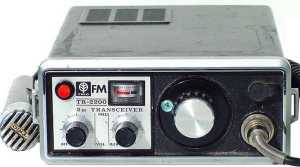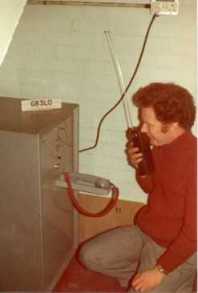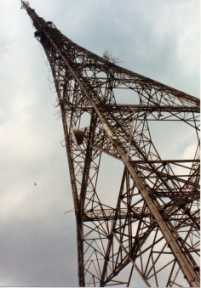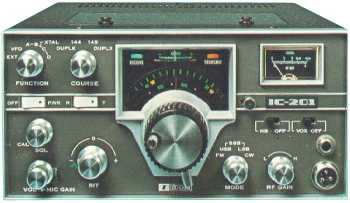AGGRO WITH THE NEIGHBOURS
For the next couple of years I was content to work with my rack mounted 2m band 50W AM transmitter and
tuning 'low to high' for a call. The 10 element yagi got out well. Too well in fact as I started to get
complaints of TVI from my next door neighbour.
I never had much to do with the guy until the day he approached me saying that I was coming 'loud and clear'
over his TV. I accepted responsibility and told him I would sort this problem out. I explained I would make a
filter that I would fit between his TV and aerial that would remove the interference. However, when I mentioned
this he turned really nasty, raising his voice saying he would take a court order out on me to stop me
transmitting and that no way he would let me into his house to fiddle with his TV.
During the argument that followed I stayed calm which probably wound him up even more. I explained that
just as he paid for a TV license to receive, I had to pass an exam as well as to pay for a license to transmit.
That what I was doing was in no sense illegal. This he didn't like at all and then threatened me saying that
he would pull down my aerial or cut through the cables if I didn't stop transmitting!
I said if that was the way he wanted to go, it was fine by me. I even gave him the telephone number of the
department at the Ministry of Posts and Telecommunications who dealt with these problems. To make sure I got
on a good footing with the Post Office engineers, I phoned them the day after the argument and explained the
problem. That I had offered to help this person, but he refused any assistance from me and that I was in the
wrong. The reply from the engineer was most encouraging. He told me not to worry, that they deal with people
like him all the time!
A couple of days later, the engineer arrived. He first wanted to check the emissions from my gear which
he done. He said he was very impressed with the way I had built my transmitter, that it was very professional
looking and with a clean signal. He asked me to put out a transmission whilst he went next door to install the
filter. This he done and the neighbour's TV was free from interference. I was quite amused when he said he
charged him for the work. Probably a co-axial cable filter that I would have made for no cost.
Was that the end of the story? Not quite! A few months later, this neigbour said that he heard me coming
over another piece of his domestic equipment. I asked him at what time and when he told me I said that was
impossible as I never transmitted at that time of day... I then told him to get stuffed! He probably never
got over the fact that my hobby was legal and there was nothing he could do about it. A year or so after the
incident they moved away. Good news!
G8DNC MOVES TO 2 METRE FM
It must have been around 1974 when a split seemed to appear amongst the Class B radio amateurs? Whether to
follow the FM or SSB fraternity. AM or 'ancient modulation' as it came to be known was gradually being favoured
less due to the introduction of commercially available 2m FM or SSB equipment. Bill was working towards single
side band and building an SSB transceiver from a RadCom article (Sept 74). A thing I do recall was the KVG 9MHz
crystal filter with matching LSB/USB crystals were very expensive. I got as far as etching the PCB, but never
got any further. Although Bill did buy those components, I vaguely recall he never finished the project and
ended up buying a LINER 2 SSB transmitter.
I asked him what he thought about FM, but he wasn't that interested. Presumably because FM doesn't have
ability to work DX as well as SSB which was his interest. I noticed in the mid 1970's when I only operated on
2 metre FM that many of the stations I worked in my AM days had disappeared from the scene. Had they really
disappeared or simply moved over to SSB? A mode I couldn't use until I bought my first 2m multimode rig
in the early 1980's.

Sometime in 1974, I got my first 2m FM rig. A Trio TR-2200 with six crystal controlled spot
frequencies fitted. I say frequencies and NOT channels. This was just before repeater and simplex channels
were introduced and the 2 metre band was still pretty open with just a few calling/working frequencies and a
beacon allocation. Although I can't recall what all the spot frequencies were, one was 144.480MHz which I
found in the June 1973 RadCom was at that time the national FM calling frequency. Later, it would be THE
FREQUENCY to use for local QSO's when some other radio amateurs along with myself formed the Coulsdon Contest
Group.
The Trio 2200 was previously owned by Steve Shorey, G3ZPS who was one of the day release students at
Bromley College. He brought the rig into my workshop one day and gave me a demo. I was well impressed. So small!
He said he was looking to sell it so I made him an offer. I recall going to Steve's house one day for an HF
demo. He lived very close to Bill in Farnborough, Kent
For the first time I now owned a piece of 2m amateur radio gear that was REALLY portable. I could use it from
my car and even sit it on my bedside table and work local stations that I could hear on the pull-out telescopic
aerial. I can't actually recall when I stopped using my 2 metre AM transmitter, but it must have been around
the time when repeaters came onto the scene in 1975.
THE START OF THE REPEATER ERA
Mike Foster G8AMG who I mentioned earlier was one of the prime movers in getting repeater operation
licensed. He done the original engineering work on GB3LO, the first London repeater at Crystal Palace.
The UK London FM Group of which I was later a member was formed on the 4th Jan 1972 and was later
responsible for the running of that repeater. During the early 1970's, there were discussions between the newly
formed repeater groups, the RSGB and the licensing authorities. I never knew what Mike's input into the repeater
debate was, but when speaking to me about it, I gathered the licensing authorities were not in favour of these
remote/automatic relaying stations in the beginning.
The first experimental UK repeater, GB3PI, (R6 - 145.150/750MHz) was set up at Pye Telecommunications
in Cambridge and licensed in August 1972. It later moved to a better site at Barkway, Herts. In mid 1974, a Mk 2
version of the repeater was implemented with time-out features to prevent repeater 'hogging'. A sign of things
to come! In September 1974, GB3LO was at Epsom Downs, Surrey undergoing tests before being moved to Crystal
Palace in March 1975. In February 1975, GB3SN was undergoing trials at Fourmarks in Hampshire. My problem
now was how to get onto them. I ordered a set of 'rocks' for the TR-2200. In the beginning just for GB3LO
(R7 - 145.175/775MHz) and a couple of simplex channels S20 (145.500MHz) and S22 (145.550MHz). I was now in
business.
GB3LO was great fun to use. In May 1975, the London FM Group issued a pamphlet, GB3LO Without Tears.
The repeater had so many features. The morse letter you heard when dropping carrier depended on how close you
were to the input frequency of 145.175MHz. If you were on frequency, you got a 'K' back, but received an
'H' or 'L' if you were a bit high or low of the input channel. Many people would fiddle about (me included)
just to receive the off frequency tones... Diddlely-dit - So, I'm a bit high now and so on! You could check
to see if your 1750Hz tone burst access was on spec also. If it was a few hertz off you couldn't open the
repeater. However, many mastered the art of 'whistling it up'. There was even a device for checking FM deviation.
If your voice got chopped during a QSO you were over modulating and needed to wind down the deviation level pot
to prevent this. In other words, it served as a useful piece of test equipment as well relaying QSO's.

In researching for information regarding GB3LO, by luck I managed to make contact (after nearly 30 years)
with Roger Glover G8IUC. Roger was also a member of the London FM group and looked after the repeater
for many years (see image). It so happens that Roger has the original log book when GB3LO was undergoing
engineering trials at Crystal Palace. He mentions: "Looking back through the log, the first transmission
(testing) at Crystal Palace seems to have taken place on the 4th March 1975 and it appears that a certain
G8DNC was worked at 18:33 from Bromley! At 17:05 the repeater was put into beacon mode. From the log, it
looks like the repeater went into talk through mode at 15:45 on the 7th March 1975". So, I must have been
one of the first stations to have accessed the repeater during testing!

The callsign was later changed to GB3SL (South London) when three more repeaters (GB3WL, GB3EL and
GB3NL) came into operation to cover the Greater London area. GB3LO certainly lived up to its nickname of
'Looney Operator'. From almost day one it was constantly abused and often difficult to have a sensible QSO
through. Full of pirates, jammers with squeaky voices, Idi Amin impersonators, music blocking the input
channel and so on. Over the years the repeater got such a bad reputation that it was taken off the air
several times; eventually forever! Being located up on the lower gallery of the TV mast at Crystal Palace
its coverage area was huge. Over looking one of the biggest cities in the world, it was not surprising that
the 'Idiot Factor' was huge also! (Photos courtesy of Roger G8IUC).
I started going G8DNC/M about this time and bought a 5/8 wave whip antenna with a curly loop ground plane
at the bottom. It had a clip that slid over a window which when raised held it in place. Sometimes I would
forget it was there and the wretched thing would fall off when I lowered the window. Going mobile was good
fun! On one occasion, I drove into the railway station at Bromley South waiting to collect my mother. Whilst
in QSO (perhaps the one logged by Roger via GB3LO), an 'old dear' come up to me and asked if I could take her
home. She obviously thought I was a mini cab! Pity I didn't take up her offer as I could have made a few quid
on the side :-)
MAKING NEW FRIENDS VIA GB3LO
GB3LO was very strong into Biggin Hill. So strong in fact that I could even get into it when in bed using
just the pull-up aerial. There were many contacts I made in those early days, but one of the most familiar
voices on at a late hour was Neil, G8JAZ in Old Coulsdon, Surrey. We used to have many a good chat
(hogging the repeater) and one day the subject got onto 'Afterburners'. What were these magical devices
(RF Power Amplifiers) that could boost the measly 1W signal from my TR-2200? Neil said he had made one and
invited me to come over sometime and take a look.
On arriving at his doorstep, I probably freaked him out as I had long hair at the time. What freaked ME
out was his shack! I'd never seen a bedroom in such disarray. Incredible how he found the bed which was
covered in bits of half built radio gear, magazines, etc. What was even MORE impressive were the vast amount
of empty beers cans lying around! I've never seen so many. The centrepiece of his shack was without doubt a
pensioned off dentist chair which he operated from. I especially liked the snooker cue he had close by to
change the channels on his TV to save him getting up! Nice one... I could see we would get on well together!

His rig was impressive too. An Icom IC201 2m multimode with VFO control which made my TR-2200
look like a toy! His shack was in a great location being on the top floor of a block of flats with a clear
horizon. At the time, I thought he had a massive aerial as he was so strong, but was surprised when we went
outside and he showed me what looked like a stick poking out from the roof of the flats. He told me it was
somewhat illegal, but it was so unobtrusive that I doubt if anyone even knew it was there. He could get into
all the repeaters that were around in SE England at the time, even GB3SN. From my QTH down in Biggin Hill
valley, I couldn't hear the Hampshire repeater at all and it was only later when I got the 'rocks' for that
channel (R5 - 145.125/725MHz) and driving along the North Downs in Surrey after building a copy of Neil's 10W
amplifier that I could access GB3SN (usually returning home from Neil's QTH after a visit to the pub)!
Shortly after meeting Neil, I met up with Laurence G4DMA who also lived in Couldson. Laurence
had decided to go for walk (pedestrian mobile!) with his TR-2200 one night and was miles from home when I
offered to drive him back. A few years later, Laurence would become a 'ham radio celebrity' when he joined
up with Sir Ranulph Fiennes as his base station radio operator during the Arctic crossing of the
TRANSGLOBE EXPEDITION in 1982 and Sir Ran's later polar
expeditions. In fact he STILL manages to get time off from work and does amateur radio from exotic DX locations.
I don't know how he manages it :-)
In the mid 1970's Neil, Laurence and myself along with some other local amateurs would form the 'Coulsdon
Contest Group' (KKC) of which will be devoted another section on this website. To put this into a better
perspective, I quote the words from Martin G4FKK, a long term KKC member:
"KKC is/was a group of beer loving radio amateurs based at one time in the North Surrey area. Interested
in pushing forward the boundaries of high-tech contesting or put another way... A bunch of people who thought
it would be fun to live in a field for a couple of days every now and again and see how many polypins of fine
traditional British ale could be disposed of" !!
To be continued...







